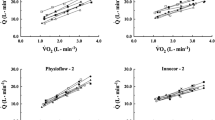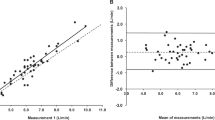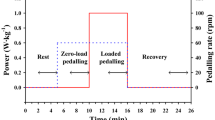Abstract
Several rebreathing methods are available for cardiac output (Q T) measurement. The aims of this study were threefold: first, to compare values for resting Q T produced by the equilibrium-CO2, exponential-CO2 and inert gas-N2O rebreathing methods and, second, to evaluate the reproducibility of these three methods at rest. The third aim was to assess the agreement between estimates of peak exercise Q T derived from the exponential and inert gas rebreathing methods. A total of 18 healthy subjects visited the exercise laboratory on different days. Repeated measures of Q T, measured in a seated position, were separated by a 5 min rest period. Twelve participants performed an incremental exercise test to determine peak oxygen consumption. Two more exercise tests were used to measure Q T at peak exercise using the exponential and inert gas rebreathing methods. The exponential method produced significantly higher estimates at rest (averaging 10.9 l min−1) compared with the equilibrium method (averaging 6.6 l min−1) and the inert gas rebreathing method (averaging 5.1 l min−1; P < 0.01). All methods were highly reproducible with the exponential method having the largest coefficient of variation (5.3%). At peak exercise, there were non-significant differences between the exponential and inert gas rebreathing methods (P = 0.14). The limits of agreement were −0.49 to 0.79 l min−1. Due to the ability to evaluate the degree of gas mixing and to estimate intra-pulmonary shunt, we believe that the inert gas rebreathing method has the potential to measure Q T more precisely than either of the CO2 rebreathing methods used in this study. At peak exercise, the exponential and inert gas rebreathing methods both showed acceptable limits of agreement.

Similar content being viewed by others
References
Agostoni P, Cattadori G, Apostolo A, Contini M, Palermo P, Marenzi G, Wasserman K (2005) Noninvasive measurement of cardiac output during exercise by inert gas rebreathing technique: a new tool for heart failure evaluation. J Am Coll Cardiol 46:1779–1781
Bland MJ, Altman DG (1986) Statistical methods for assessing agreement between two methods of clinical measurements. Lancet 89:307–310
Bruce RA, Kusumi F, Hosmer D (1973) Maximal oxygen intake and nomographic assessment of functional aerobic impairment in cardiovascular disease. Am Heart J 85:546–542
Christensen P, Clemensen P, Anderson PK, Henneberg SW (2000) Thermodilution versus inert gas rebreathing for estimation of effective pulmonary blood flow. Crit Care Med 28:51–56
Clausen JP, Larsen OA, Trap-Jensen J (1970) Cardiac output in middle-aged patients with CO2 rebreathing method. J Appl Physiol 28:337–342
Collier CR (1956) Determination of mixed venous CO2 tensions by rebreathing. J Appl Physiol 9:25–29
Cowley AJ, Stainer K, Murphy DT, Murphy J, Hampton JR (1986) A non-invasive method for measuring cardiac output: the effect of Christmas lunch. Lancet 2:1422–1444
Da Silva GA, Al-Manshawi A, Heigenhauser GF, Jones NL (1985) Measurement of mixed venous carbon dioxide pressure by rebreathing during exercise. Resp Physiol 59:379–392
Damgaard M, Norsk P (2005) Effects of ventilation on cardiac output determined by inert gas rebreathing method. Clin Physiol Funct Imaging 25:142–146
De Abreu MG, Quintel M, Ragaller M, Albrecht DM (1997) Partial carbon dioxide rebreathing: a reliable technique for noninvasive measurement of nonshunted pulmonary capillary blood flow. Crit Care Med 25:675–683
Defares JG (1958) Determination of P vCO2 from exponential CO2 rise during rebreathing. J Appl Physiol 13:159–164
Ferguson RJ, Faulkner JA, Julius S, Conway J (1968) Comparison of cardiac output determined by CO2 rebreathing and dye-dilution methods. J Appl Physiol 25:450–454
Franciosa JA (1977) Evaluation of CO2 rebreathing cardiac output method in seriously ill patients. Circulation 55:449–455
Gabrielsen A, Videbek R, Schou M, Damgaard M, Kastrup J, Norsk P (2002) Non-invasive measurement of cardiac output in heart failure patients using a new foreign gas rebreathing technique. Clin Sci 102:247–252
Guyton AC, Hall JE (1996) Textbook of medical physiology. Saunders, USA
Hamilton WF (1962) Measurement of cardiac output. In: Fenn WO, Rahn H (ed) Handbook of physiology. American Physiological Society, Washington DC, pp 551–584
Hansen JE, Ulubay G, Chow BF, Sun XG, Wasserman K (2007) Mixed-expired and end-tidal CO2 distinguish between ventilation and perfusion defects during exercise testing in lung and heart disease. Chest 132:977–983
Holmgren AP (1960) The reproducibility of cardiac output determination by the direct Fick method during muscular work. Scan J Clin Lab Invest 12:224–227
Muiesan G, Solinas SC, Grassi V, Casucci G, Petz E (1968) Comparison of CO2-rebreathing and direct Fick methods for determining cardiac output. J Appl Physiol 24:424–429
Neviere R, Mathieu D, Riou Y, Guimez P, Renaud N, Changon JL, Wattel F (1994) Carbon dioxide rebreathing method of cardiac output measurement during acute respiratory failure in patients with chronic obstructive pulmonary disease. Crit Care Med 22:81–85
Nugent AM, McParland J, McEneaney DJ, Steele I, Campbell NP, Stanford CF, Nicholls DP (1994) Non-invasive measurement of cardiac output by carbon dioxide rebreathing method at rest and during exercise. Eur Heart J 15:361–368
Ohlsson J, Wranne B (1986) Non-invasive assessment of cardiac output and stroke volume in patients during exercise. Evaluation of CO2 method. Eur J Appl Physiol 55:538–544
Quanjer PH, Tammeling GJ, Cotes JE, Pedersen OF, Peslin R, Yernault JC (1993) Lung volumes and forced vital flows. Eur Resp J Suppl 16:5–40
Reybrouck T, Amery A, Billiet L, Fagard R, Stijns H (1978) Comparison of cardiac output determined by carbon dioxide-rebreathing and direct Fick method at rest and during exercise. Clin Sci Mol Med 55:445–452
Rogers G, Walt van der W (1997) An evaluation of exercise cardiac output using the CO2 rebreathing extrapolation technique. J Appl Physiol Occup Physiol 75:431–434
Sackner MA (1987) The respiratory system. In: Fishman AP (ed) Handbook of physiology. American Physiological Society, Bethesda, pp 233–255
Stringer WW, Hansen JE, Wasserman K (1997) Cardiac output estimated nonivasively from oxygen uptake during exercise. J Appl Physiol 82:908–912
Vanhees L, Defoor J, Schepers D, Brusselle S, Reybrouck T, Fagard R (2000) Comparison of cardiac output measured by two automated methods of CO2 rebreathing. Med Sci Sports Exerc 32:1028–1034
Wasserman K, Hansen JE, Sue DY, Casaburi R, Whipp BJ (1999) Principles of exercise testing and interpretation. Lippincot Williams and Wilkins, Baltimore
Zeidifard E, Silverman M, Godfrey S (1972) Reproducibility of indirect (CO2) Fick method for calculation of cardiac output. J Appl Physiol 33:141–143
Author information
Authors and Affiliations
Corresponding author
Rights and permissions
About this article
Cite this article
Jakovljevic, D.G., Nunan, D., Donovan, G. et al. Comparison of cardiac output determined by different rebreathing methods at rest and at peak exercise. Eur J Appl Physiol 102, 593–599 (2008). https://doi.org/10.1007/s00421-007-0631-4
Accepted:
Published:
Issue Date:
DOI: https://doi.org/10.1007/s00421-007-0631-4




